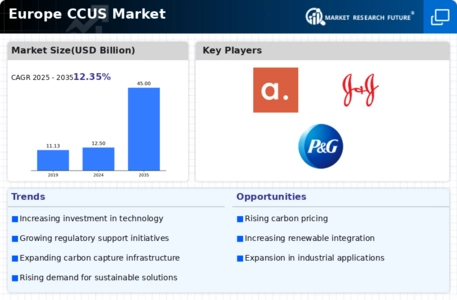Market Analysis
In-depth Analysis of EUROPE CCUS Market Industry Landscape
The Europe CCUS (Carbon Capture, Utilization, and Storage) market is poised for substantial growth, driven by a confluence of market factors that reflect both regional and global dynamics. One of the primary catalysts for the expansion of the CCUS market in Europe is the increasing emphasis on environmental sustainability and carbon mitigation. As the European Union (EU) continues to prioritize ambitious climate goals, including achieving carbon neutrality by 2050, there is a growing recognition of the pivotal role that CCUS technologies play in reducing greenhouse gas emissions.
Government policies and regulations constitute another crucial market factor shaping the landscape of CCUS adoption in Europe. The EU has been proactive in establishing a regulatory framework that incentivizes the deployment of CCUS technologies. Initiatives such as the European Green Deal and the EU Emissions Trading System (ETS) provide a supportive environment for businesses and industries to invest in carbon capture and storage solutions. This regulatory backing not only encourages existing industries to adopt CCUS but also promotes the emergence of new market players and innovations in the CCUS sector.
The economic landscape also contributes significantly to the market dynamics of CCUS in Europe. Industries with high carbon emissions, such as energy-intensive manufacturing and power generation, face increasing pressure to decarbonize their operations. As a result, these industries are exploring CCUS technologies as a viable means to mitigate their carbon footprint while maintaining competitiveness. The economic benefits of deploying CCUS, including potential job creation, infrastructure development, and long-term cost savings, further enhance the market appeal of carbon capture and storage solutions.
Collaboration and partnerships between public and private entities form another pivotal factor influencing the growth of the Europe CCUS market. Governments, research institutions, and industry stakeholders are increasingly joining forces to accelerate the development and deployment of CCUS technologies. This collaborative approach fosters knowledge sharing, technology innovation, and investment, creating a synergistic effect that propels the CCUS market forward. Public-private partnerships, as well as international collaborations, are instrumental in addressing the complex challenges associated with scaling up CCUS infrastructure.
Technological advancements and innovation play a crucial role in shaping the trajectory of the CCUS market in Europe. Ongoing research and development efforts focus on enhancing the efficiency, scalability, and cost-effectiveness of carbon capture and storage technologies. Breakthroughs in materials science, engineering, and process optimization contribute to making CCUS more viable and attractive for a broader range of industries. As technological barriers continue to be overcome, the market potential for CCUS in Europe expands, providing a robust foundation for sustained growth.
Furthermore, the financial landscape is a significant market factor influencing the adoption of CCUS technologies in Europe. Investment in CCUS projects, both public and private, is increasing as stakeholders recognize the long-term value of these initiatives. Financial instruments, subsidies, and incentives provided by governments and international organizations contribute to making CCUS projects economically viable. This financial support serves as a key driver for businesses and industries to integrate CCUS into their carbon reduction strategies.
In conclusion, the Europe CCUS market is shaped by a multifaceted interplay of factors, ranging from regulatory frameworks and economic considerations to technological advancements and collaborative initiatives. As the region strives to meet ambitious climate targets, the CCUS market is poised for significant expansion, offering not only environmental benefits but also economic opportunities for stakeholders across various industries. The convergence of these market factors positions CCUS as a critical component in Europe's journey toward a more sustainable and low-carbon future.

















Leave a Comment